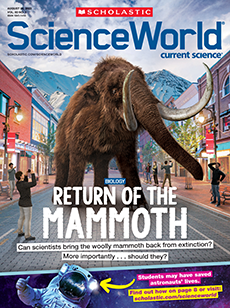ROSHAN PATEL/SMITHSONIAN CONSERVATION BIOLOGY INSTITUTE
NEW MOM: Antonia, a cloned black-footed ferret
Last summer, the Smithsonian National Zoo and Conservation Biology Institute in Virginia welcomed two new residents: baby black-footed ferrets! There’s something extra-special about these kits. Their mom, Antonia, is a clone—an identical copy of a black-footed ferret that lived more than 40 years ago. The babies, Sibert and Red Cloud, are the first healthy offspring born in the United States to a clone of an endangered species.
About 350 black-footed ferrets live in the wild today. All are descended from just seven ferrets, which biologists started breeding in the 1980s. Because the population is so closely related, the animals are more likely to have health problems. But Antonia is unrelated to wild ferrets alive today. The clone and her babies can help increase the genetic diversity of the species. “This is a huge boost to ferret populations,” says Adrienne Crosier, a biologist at the Smithsonian.
